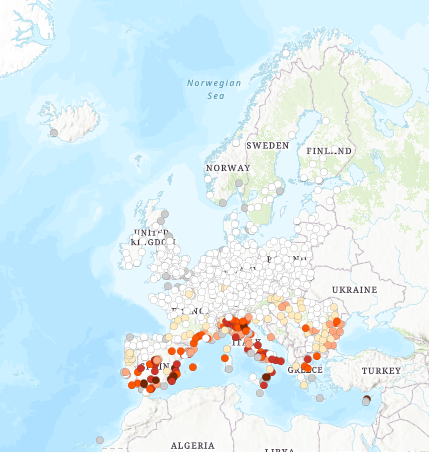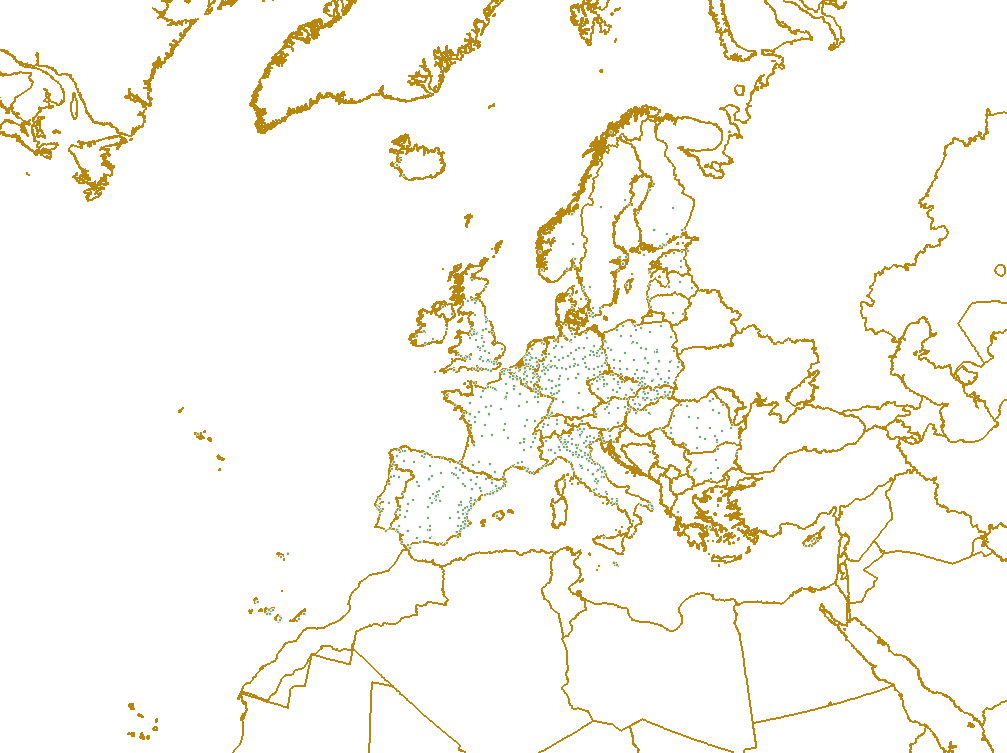Atmospheric conditions
Type of resources
Available actions
Topics
INSPIRE themes
Keywords
Contact for the resource
Provided by
Years
Formats
Representation types
Update frequencies
status
Service types
Scale
Resolution
-

The dataset presents average values of the number of days per year where the maximum temperature has exceeded 35 degrees Celsius from the period 1987- 2016, for a series of individual European cities from Eurostat's Urban Audit 2011-2014 spatial dataset. The associated values are based on the E-OBS dataset from the EU-FP6 project ENSEMBLES (http://ensembles-eu.metoffice.com) and around 10,000 meteorological stations across Europe. This dataset has been used also in the EEA Report No 22/2018 "Unequal exposure and unequal impacts: social vulnerability to air pollution, noise and extreme temperatures in Europe" (https://www.eea.europa.eu/publications/unequal-exposure-and-unequal-impacts/at_download/file).
-

The dataset presents the average number of combined hot days - with maximum temperature over 30 degrees Celsius - and tropical nights - with minimum temperature over 20 degrees Celsius - in the period 1987-2016, for a series of individual European cities from Eurostat's Urban Audit 2011-2014 spatial dataset. The associated values are based on the E-OBS dataset from the EU-FP6 project ENSEMBLES (http://ensembles-eu.metoffice.com) and around 10,000 meteorological stations across Europe. The combination of hot days and warm nights is particularly dangerous to human health, as the high temperatures during night time does not allow for the cities and buildings to cool down. Such combination, if lasting over several days (heatwaves) can have severe health implications or even be fatal to the elderly, babies or those in poor health. Therefore, the knowledge of the occurrence of such conditions in a given location can be useful in planning adaptation to the changing climate and protection of the vulnerable groups from heat. This dataset has been used also in the EEA Report No 22/2018 "Unequal exposure and unequal impacts: social vulnerability to air pollution, noise and extreme temperatures in Europe" (https://www.eea.europa.eu/publications/unequal-exposure-and-unequal-impacts/at_download/file).
-

This dataset represents the observed trend in maximum annual five day consecutive precipitation over Europe, between 1960 and 2015, during the winter season (December, January, February). Heavy precipitation events have become more intense and more frequent in Europe on average, but there are important differences across regions, seasons, time periods, heavy precipitation indices and underlying datasets. Studies generally agree that heavy precipitation has become more intense in northern and north-eastern Europe since the 1950s, even though not all changes are statistically significant. Different studies and indices show diverging trends for south-western and southern Europe. Heavy precipitation may lead to local surface water flooding in cities, therefore should be considered in adaptation planning. This dataset is used also in the EEA Indicator "Heavy precipitation in Europe": https://www.eea.europa.eu/data-and-maps/indicators/precipitation-extremes-in-europe-3/assessment, which in the meantime has been updated.
-

This gridded dataset presents the projected changes (in percentage) in heavy precipitation in winter season (December, January, February) in Europe, from 1971-2000 to 2071–2100 for the Representative Concentration Pathways (RCP) 8.5 scenario, based on the ensemble mean of different Regional Climate Models (RCMs) nested in different General Circulation Models (GCMs). This dataset is an output of the EURO-CORDEX data, produced in the context of the EURO-CORDEX initiative. EURO-CORDEX is the European branch of the CORDEX initiative, producing ensemble climate simulations based on multiple dynamical and empirical-statistical downscaling models forced by multiple global climate models from the Coupled Model Intercomparison Project Phase 5 (CMIP5). More information about this initiative on: https://www.euro-cordex.net/060374/index.php.en. The dataset has been used in the EEA Indicator "Heavy precipitation in Europe": https://www.eea.europa.eu/data-and-maps/indicators/precipitation-extremes-in-europe-3/assessment, which in the meantime has been updated.
-

This gridded dataset represents the observed trend in maximum annual five day consecutive precipitation over Europe, between 1960 and 2015, during summer (June, July, August). Heavy precipitation events have become more intense and more frequent in Europe on average, but there are important differences across regions, seasons, time periods, heavy precipitation indices and underlying datasets. Studies generally agree that heavy precipitation has become more intense in northern and north-eastern Europe since the 1950s, even though not all changes are statistically significant. Different studies and indices show diverging trends for south-western and southern Europe. Heavy precipitation may lead to local surface water flooding in cities, therefore should be considered in adaptation planning. This dataset is used also in the EEA Indicator "Heavy precipitation in Europe": https://www.eea.europa.eu/data-and-maps/indicators/precipitation-extremes-in-europe-3/assessment, which in the meantime has been updated.
-

Near real time benzene concentration measurements transmitted to EEA by national and regional air quality networks (http://www.eea.europa.eu/themes/air/air-quality/resources/who-provides-the-air-quality-data). The measurements are preliminary and may be changed at any time by the data providers following their quality control procedures. The measurements may not be used for compliance purposes.
-

Near real time concentration of PM2.5 measurements transmitted to EEA by national and regional air quality networks (http://www.eea.europa.eu/themes/air/air-quality/resources/who-provides-the-air-quality-data). The measurements are preliminary and may be changed at any time by the data providers following their quality control procedures. The measurements may not be used for compliance purposes.
-

Near real time nitrogen oxides (NOx) concentration measurements transmitted to EEA by national and regional air quality networks (http://www.eea.europa.eu/themes/air/air-quality/resources/who-provides-the-air-quality-data). The measurements are preliminary and may be changed at any time by the data providers following their quality control procedures. The measurements may not be used for compliance purposes.
-

Near real time carbon monoxide (CO) concentration measurements transmitted to EEA by national and regional air quality networks (http://www.eea.europa.eu/themes/air/air-quality/resources/who-provides-the-air-quality-data). The measurements are preliminary and may be changed at any time by the data providers following their quality control procedures. The measurements may not be used for compliance purposes.
-

Near real time sulphur dioxide (SO2) concentration measurements transmitted to EEA by national and regional air quality networks (http://www.eea.europa.eu/themes/air/air-quality/resources/who-provides-the-air-quality-data). The measurements are preliminary and may be changed at any time by the data providers following their quality control procedures. The measurements may not be used for compliance purposes.
 RUC Geo-Data catalogue
RUC Geo-Data catalogue